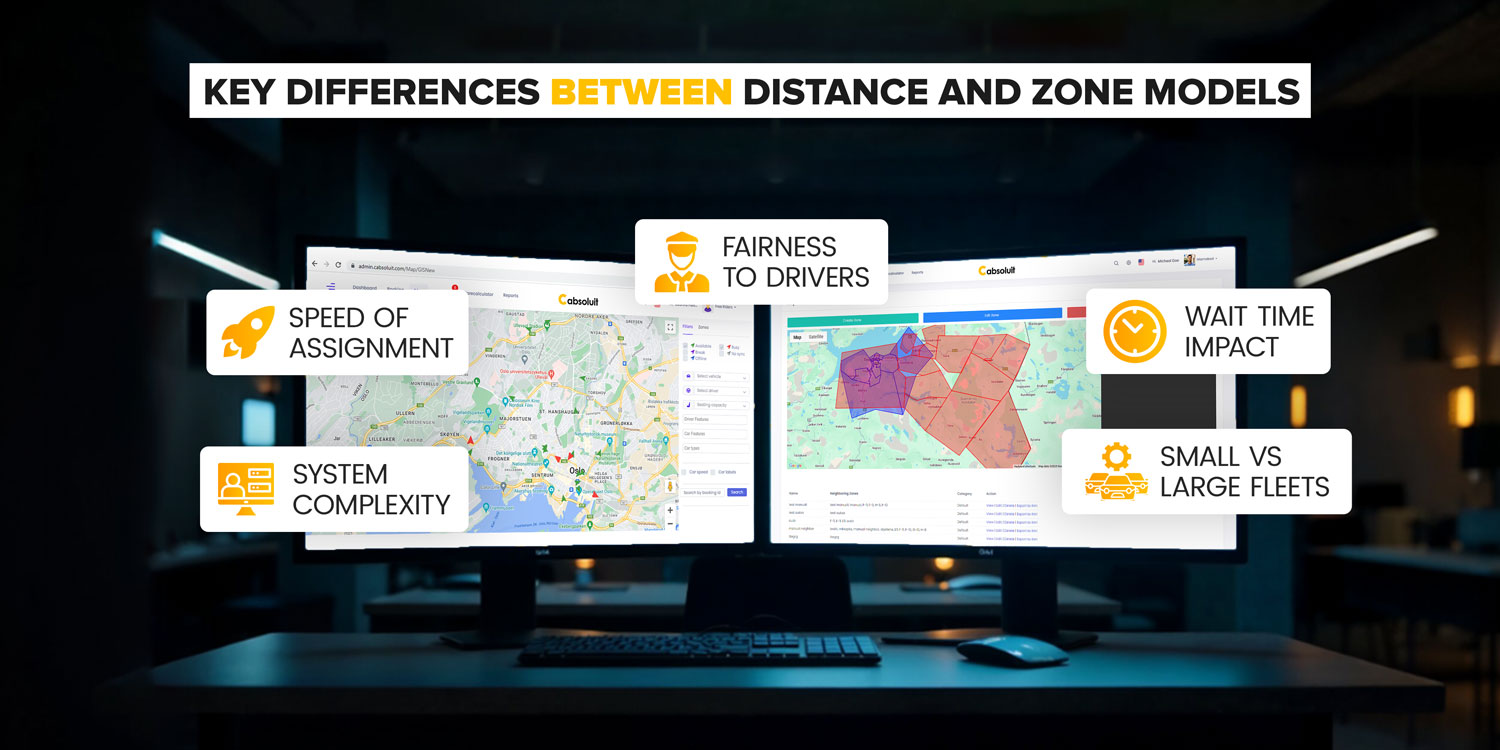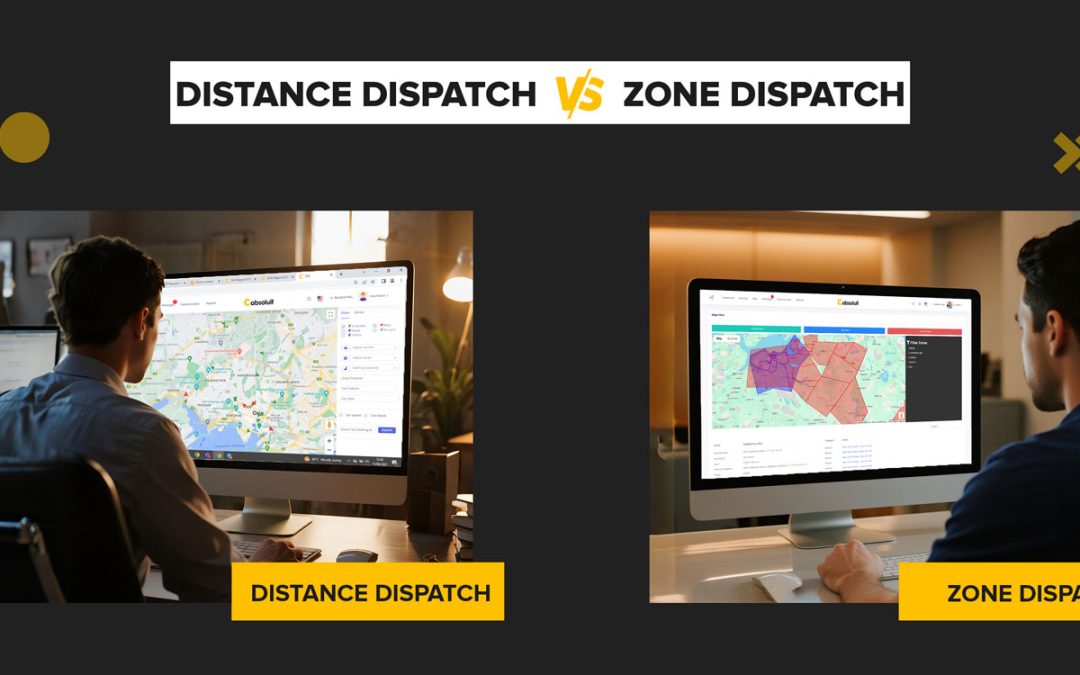In the case of taxi companies, the selection of dispatch model may prove to be significant. An effective system enables fleet operators to handle drivers in a more effective manner, minimize idleness and enhance customer satisfaction. Passengers will have an improved response time, whereas drivers will have equal ride allocation and a stable job.
There are two most common solutions, distance-based dispatch and zone-based dispatch. They are both popular in local taxis and massive fleets throughout the world. Both models have their advantages and difficulties, and knowledge of their operations is what any taxi business, which plans to grow and remain competitive, needs to know.
What is a Distance-Based Dispatch Model?
The distance-based dispatch system functions by delivering the ride to the nearest taxi. It works with real time GPS positioning to ensure the location of each driver and dispatch the task to a car closest to the job. This ensures that the ride assignment is fast, and the passengers are picked up at a faster rate.
This model has a number of benefits to taxi firms and fleet owners. It saves drivers idle time, enhances efficiency of the ride and conserves fuel as cars do not need to travel long distances to access passengers. Passengers enjoy reduced waiting time and better services.
But there is also a problem. When there is low demand, drivers may be scattered in a very uneven way, thus leaving some of the areas unoccupied. The system also presupposes powerful dispatch software to handle real-time information, and this makes it more complicated to operate as compared to simple models by taxi companies.
Related Article: Taxi Dispatch Software – The Complete Guide
Related Article: 5 Must Have Features in a Taxi Dispatch System – 2025
Key Differences Between Distance and Zone Models
Both the distance-based dispatch and zone-based dispatch are employed broadly in the taxi services though they operate differently. Knowledge of the differences assists taxi companies, dispatchers and fleet operators to select the appropriate system to suit their business.

1. Speed of Assignment
The distance dispatch normally allocates rides in a shorter time because the ride is dispatched to the nearest driver via GPS tracking. When a zone is occupied, or has less cars to offer, it could be longer in zone dispatch.
2. Fairness to Drivers
Zone dispatch has also been perceived fair to drivers since jobs are assigned through a queue method. In distance dispatch, drivers who are relatively nearer to areas of high demand are usually assigned more rides and this may cause others to wait longer.
3. System Complexity
A distance-based dispatching system relies on superior taxi dispatch software and tracking. Zone based dispatch is easier to operate and might not be equally efficient in large service areas.
4. Scalability for Fleets
In large cities with large fleets, distance dispatch is a good solution since it is able to manage a lot of drivers and trips simultaneously. Zone dispatch is simpler to control when there are a small or medium fleet and fairness, and simplicity are more important than speed.
5. Customer Wait Time
Distance-based dispatch also tends to make passengers wait less, as the nearest car is dispatched. Wait times may be higher in case no car is free in a particular zone in zone dispatch.
Related Article: How Cabsoluit Automates School Runs with an Advanced School Dispatch System
Related Article: How Recurring Bookings Simplify UK School Run Taxi Services
Use of Distance Dispatch
The distance-based system is one that transmits the job to the closest available car through real-time GPS tracking. It glows when the requests are frequent and near to each other.
Best situations
- High-demand city center
- Large fleets that need fast turnarounds
- Peak hours when speed matters most
Why it works
It saves time on picking the vehicle since it selects the nearest driver when requested. It reduces the dead miles per trip. It requires a powerful dispatch software to handle live locations.
When to Use Zone Dispatch
A zone-based system breaks down the service area into zones and assigns jobs in each zone to a queue. This will ensure that taxis are kept close to places where they will be booked by the passengers.
Best situations
- Small to medium sized fleets which desire fair rotation.
- Cities or non-towns where the coverage is important.
- Scheduled work and pre-bookings.
Why it works
It spreads drivers across the map, so coverage stays strong and predictable. Drivers know their place in the queue. Operators can tune zone rules to match demand and reduce gaps.
Hybrid Approaches: Mixing Both Models
Modern taxi dispatch systems, including Cabsoluit, are not limited to choosing only zone-based or zoneless dispatch. Instead, they offer the flexibility to use both, depending on what the situation demands.
How Hybrid Dispatch Works
Operators can configure their dispatch system so that zone-based rules apply during normal hours when demand is steady. During peak times, such as rush hour or large events, the system can switch to zoneless (distance-based) logic. This allows the nearest available car to be assigned quickly, reducing passenger wait time.
Benefits of Hybrid Dispatch
Flexibility for Operators
Fleet operators can adapt their strategy based on time of day, traffic, and booking volume.
Better for Drivers
Hybrid models balance fairness and efficiency. Drivers get fairer distribution during quiet times and more frequent jobs when demand spikes.
Improved Passenger Experience
Passengers enjoy shorter waiting times in busy periods and consistent coverage in quieter hours.
By combining both models, Cabsoluit gives taxi companies full control to respond to local demand, improve ride efficiency, and maintain reliable taxi service.
Choosing the Right Model for Your Taxi Business
Choosing an appropriate taxi dispatch system is among the biggest decisions of any taxi or private hire company. Distance-based and zone-based dispatch are both choices that are determined by a number of key issues including the fleet size, area of service, demand patterns, and the expectations of customers.
In the case of larger fleets that operate in busy cities, distance-based dispatch model is usually the most effective. It is based on the real-time GPS position and intelligent algorithms in the taxi dispatch software to allocate the closest driver in real-time.
This will decrease waiting time, ensure drivers are busy, and enhance the entire experience that the customers have. Smaller or middle sized taxi firms might be inclined to use the zone dispatch model.
It is more rational in terms of allocating rides and assists in keeping the drivers fair, particularly in those areas where the demand is not constant but remains constant. Here plays a large part by technology.
The finest taxi management software will provide the operators with flexibility to alternate through models or even to utilize both simultaneously. Technology-enabled cab dispatch software solutions currently comprise of the automation tool, an analytics dashboard, and custom settings that can be tailored to any business requirement.
This is further facilitated by platforms such as Cabsoluit. Their taxicab dispatch software also allows distance and zone dispatch model which enables the operators to vary strategies on a daily basis, on the basis of traffic, number of bookings, or surge hours. This degree of flexibility assists taxi firms to grow more rapidly and at the same time provide trustworthy and dependable services.
Concisely, the correct model is that which suits your particular fleet. With the help of the matching dispatch software and the well-defined business objectives, a taxi company will be able to increase its efficiency, spend less, and retain occupants content with their service on a daily basis.
Conclusion
Distance-based and zone-based models of dispatch possess advantages. The appropriate option will be based on the size of your fleet, geographical coverage, and objectives of the business.
Distance-based delivery is excellent in busy towns where speed is the most important. Zone-based dispatch is effective with small fleets that are concerned with fairness and structure.
A hybrid dispatch system is one in which many companies are enjoying the benefits of both this time around. It assists fleets to be flexible, respond to customers quicker, and to ensure that drivers are happy.
Ultimately, a fit-to-purpose dispatching system would be most appropriate because as your business expands, the system would accommodate the changes. By using the proper taxi dispatch software, you will be able to create a smarter, more reliable and efficient taxi service.
FAQs
What is the difference between distance-based and zone-based dispatch?
Zone-based dispatch divides the city into zones and assigns rides in order.




